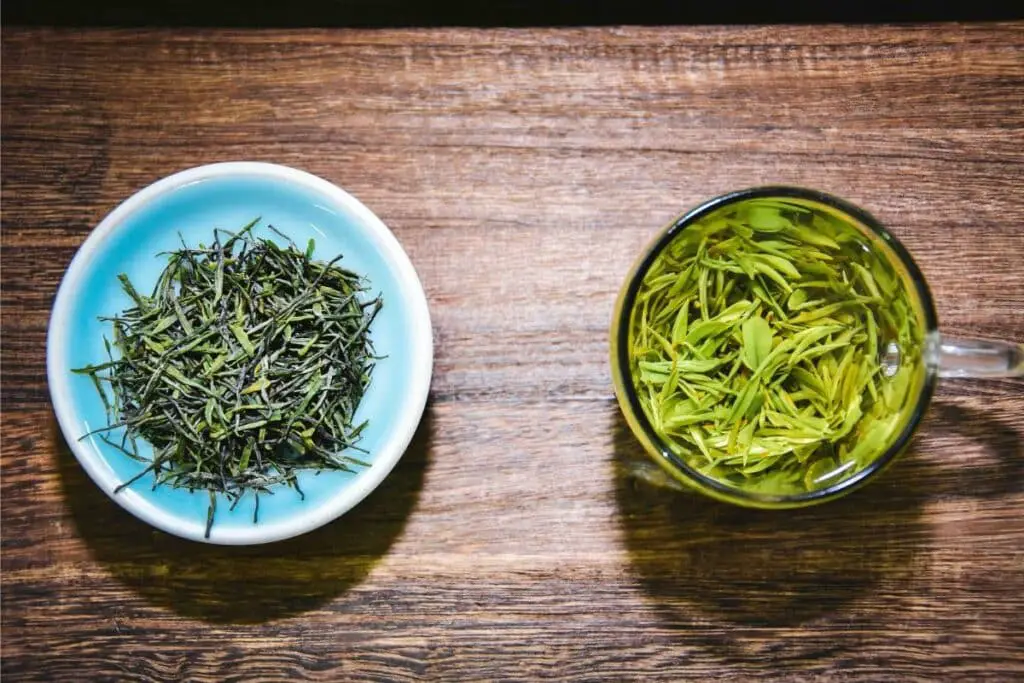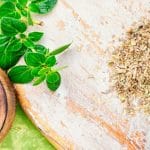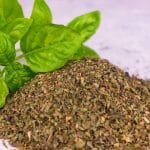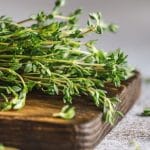In summary: Some of the rosemary substitutes are thyme, dried or fresh oregano, basil, marjoram, tarragon, etc. We also give tips on how to choose the best substitute depending on the recipe and personal preference below.
Native to the Mediterranean, rosemary is a popular herb in savory dishes, especially roasts, meat, vegetables, and seasoned bread. Both dried and fresh rosemary can be used in cooking and last a little longer than other more fragile herbs.
If you are just about to put that roast in the oven and realize you’re all out of rosemary, keep calm and choose one of our best rosemary substitute ideas below. There are a variety of herbs from the same mint family that can be used in a pinch.
Below we’ll help you choose the best substitutes for rosemary according to the dish you are making, whether it’s a lamb dish, baked goods, or sausage dishes.
What Is Rosemary?
Not quite as delicate as most other herbs, fresh rosemary has thin needle-like leaves and a woody stem. The evergreen shrub is part of the mint family which also includes basil, oregano, lavender, and thyme.
A rosemary plant can grow as an upright shrub or as a ground cover and there are a variety of types within each category of which only some are used for cooking.
The woodsy herb is well-known for its pine-like flavor and unique aromatic rosemary smell. It flowers in white, blue, pink, or purple blossoms. Although the flowers aren’t commonly seen in stores, fresh rosemary flowers can also be used in cooking.
Rosemary is most popularly used in hearty meat and vegetable dishes and pairs well with lamb, beef, pork, and poultry as well as potato and root vegetable dishes, barbecues, stews, and soups.
How to Cook with Fresh and Dried Rosemary
Whether you’re cooking with dried or fresh rosemary leaves, adding it to your dish at the beginning of the cooking time will help to release the oils and impart flavor.
Whole sprigs can be added to roasted meats or when making stews, however, remove these before serving as the woody stem is not pleasant to bite on.
You can use fresh or dried rosemary interchangeably, however, you will need to change the quantity you use since the dried version is more intense.
If your recipe calls for one teaspoon of the fresh herb, use only ¼ teaspoon of the dried herb. A tablespoon of any fresh herb, in general, should be substituted with only a teaspoon of the dried version.
All the below rosemary substitutes can be replaced measure for measure (unless otherwise stated) when using fresh herbs for fresh rosemary and dried herbs in place of the dried version.
When replacing dried rosemary for fresh (or fresh for dried) use the above ratio conversions as a guideline.
If your recipe calls for a sprig of fresh rosemary, this will equate to around one teaspoon of fresh leaves.
Best Rosemary Substitutes
#1. Thyme
Both fresh or dried thyme are generally quite easy to find in grocery stores. This herb belongs to the same plant family and has small leaves with an earthy, peppery taste, and aromatic savory flavor.
Like rosemary, it can be used on the sprig which makes it a great substitute when your recipe calls for a ‘sprig of rosemary. Remember to remove the stem before serving when using it this way. Thyme has a milder flavor but pairs well with a wide range of similar dishes.
Goes well with: Grilled meats, beef, lamb, game, poultry, fish, seafood, pasta dishes, savory bread or muffins, and root vegetables
Related: What can you replace thyme with?
#2. Dried or Fresh Oregano
This is another herb that is easy to find in the dried spice aisle. Oregano is a savory herb with deep earthy and peppery notes. The leaves can be used fresh or dried and are especially great in Mediterranean dishes.
Goes well with: Chicken, fish, salad dressings, pizza, tomato-based pasta sauces, and stew
#3. Basil
Fresh basil has a very different look and texture but its incredibly aromatic flavor makes it a suitable alternative to rosemary.
Depending on the type of basil you use, it will add a slight pepperiness with a touch of sweet and bitter. Mint, cinnamon, lemon, and anise undertones are also characteristic of different basil varieties.
If you are trying a dessert recipe and need a substitute, this leafy green herb is the best option. It is also a fantastic choice for Italian and Mediterranean dishes.
Goes well with: Beef, veal, chicken, vegetables, salad, and pasta dishes
#4. Marjoram
Marjoram is a lovely aromatic, woody-tasting herb with citrusy flavor undertones and a slightly bitter taste. Marjoram does not retain its flavor when cooked for long. When using fresh marjoram as a replacement in cooked dishes, add it towards the end of the cooking process.
Goes well with: Poultry, sausages, meaty dishes, stews, stuffing, vegetables, and tomato-based pasta dishes
See more: What can I use instead of marjoram?
#5. Tarragon
Tarragon brings a somewhat different flavor since it has background notes of anise. It also has a pepperiness and hint of citrus. Although you can use fresh and dried varieties, it is generally preferred fresh since the dried version is not always as flavorful.
Having said that, this is one herb you want to add less of when used as a rosemary leaves substitute, especially if you aren’t familiar with the flavor. Start with only half the amount of tarragon. As with marjoram, it is best to add fresh leaves towards the end of the cooking time.
Pairs well with: Chicken, eggs dishes, fish, and vegetables
See more: What can I use instead of tarragon?
#6. Savory
Fresh savory is available in two main categories; summer and winter savory. Although you can use either type as an alternative, keep in mind that they taste slightly different with summer savory displaying a minty undertone.
Savory can be used fresh or dried as a substitute for rosemary and is especially great when looking for a replacement in lamb or barbecue dishes.
Pairs well with: Lamb, poultry, fish, sausages, pies, stews, beans, veggies, barbeques, as well as a variety of egg and meat dishes
#7. Sage
With its soft, feathery, oblong leaves, fresh or dried sage can be used in cooking. It can also be found dried and ground for meat rubs.
With an earthy flavor and hints of mint, pine, and lemon, it is best used in heavier dishes that won’t be overpowered by the strong flavor. It can be very successful in recipes that contain garlic, onion, and fatty meats.
A combination of sage and thyme is especially a good option in poultry recipes to bring a little more depth of flavor. If you are combining the herbs use only half the amount of sage and equal amounts of thyme.
Best used in: Turkey stuffing, pork sausages, and flavoring butter to pair with seafood and vegetables
See more: What can I use in place of sage?
#8. Italian Seasoning
Italian seasoning in a dry herb blend that can bring bags of flavor to your dish. The herb mix generally includes rosemary, sage, marjoram, oregano, basil, and thyme. These herbs bring earthy, peppery, and woody flavors.
Since it already contains rosemary, you’ll get some of the same flavor notes. This is a great dried rosemary substitute for a wide range of dishes, but keep in mind that since it contains such a variety of aromatic herbs already, you’ll want to be careful if you add any other seasonings to the dish.
Use less Italian seasoning as a replacement. Start with only half the amount your recipe calls for and add to taste if needed.
Pairs well with: Meat, poultry, stews, veggies, and pasta dishes
#9. French Herbes de Provence
As with Italian seasoning, this rosemary replacement is a dried herb blend. Herbs de Provence generally has a base of parsley, rosemary, fennel, marjoram, tarragon, and thyme. Some versions also include lavender, bay leaves, sage, summer savory, or chervil.
Since the blend already contains rosemary, it will bring similar flavors to your dish. However, there will be more depth with added nuances that could change the flavor profile.
If your recipe calls for other herbs that are already part of the herb blend, you can use Herbes de Provence as a single replacement to prevent any of the flavors from overtaking your dish.
If your recipe calls for thyme and rosemary, you can leave out both herbs when using Herbes de Provence instead.
Pairs well with: Meat, fish, poultry, and stews
FAQs
What is the best way to replace rosemary in fish dishes?
Replacing rosemary in fish dishes can be done with herbs like thyme, dill, or tarragon, which also offer complementary flavors and can enhance the taste of the dish. Experiment with small quantities to find the herb that suits your preferences and the particular fish you’re cooking.
What can I use to substitute rosemary in goat recipes?
In goat recipes, you can substitute rosemary with herbs like thyme, oregano, or savory, which can provide a similar earthy and aromatic flavor profile that complements the meat. Adjust quantities based on your taste preferences and the specific dish you’re preparing.
What can I use to substitute dried rosemary when making sausages?
When making sausages, you can substitute dried rosemary with other dried herbs such as thyme, sage, or marjoram. These herbs can add depth of flavor and aroma to your sausages, enhancing the overall taste of the dish.
Are rosemary and thyme a good combination?
Yes, rosemary and thyme are a classic and complementary combination of herbs, often used together to enhance a wide range of dishes. They bring a harmonious blend of earthy and aromatic flavors that can elevate the overall taste of your culinary creations.
What can I use if I don’t have thyme or rosemary?
If you don’t have thyme or rosemary, you can consider using herbs like oregano, sage, or marjoram as alternatives. These herbs can provide similar aromatic and savory notes to your dishes, depending on the flavor profile you’re aiming for.
Conclusion
Since rosemary can be harvested almost any time of year and is quite an easy herb to cultivate, it’s a great shrub to have in your garden or on your patio. If you have a surplus, you can always dry the herb or even freeze it. However, when you’re all out, a substitute is the next best option.
In most cases, thyme, oregano, and basil all make a suitable alternative. If you don’t have these, opt for tarragon, savory, marjoram, or sage.
While dill and chives are best used in fish dishes, pre-blended dried herb mixes such as Italian seasoning or Herbes de Provence can add a good flavor burst to meat, poultry, and stews.
See more: How to dry fresh rosemary in oven
*image by Tuchong-Microstock6/depositphotos









